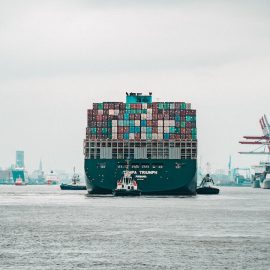

This article is an excerpt from the Shortform book guide to "Economics in One Lesson" by Henry Hazlitt. Shortform has the world's best summaries and analyses of books you should be reading.
Like this article? Sign up for a free trial here .
Does the free-market system help or hinder the national interest? Do you think it’s better to let the economy run its course or to intervene?
Many people believe that a free-market system—one in which supply and demand dictate prices for goods—serves the desires of greedy businesses rather than the consumers and the national wealth. But the price system naturally diverts capital and manpower to the industries that produce most efficiently and contribute the most to national wealth.
Here’s why the free-market system is actually better for both consumers and the national interest.
The Free-Market Price System
Many people falsely believe that the price system hurts productivity and national wealth because industries only make goods as long as they’re profitable, which:
- Limits productivity and, thus, national wealth
- Prevents consumers from having ample supplies of goods
These opponents of the free-market system argue that instead of producing only enough laptops to meet demand, manufacturers should produce as many laptops as their factories can put out. In their view, this approach would prevent laptop shortages and price hikes due to limited supply. However, this view overlooks the fact that there is a finite amount of capital and manpower to produce those goods, meaning that all industries can’t produce at full steam at all times.
As an analogy, if a family is stranded on a desert island, they divide the labor in order to survive: The children find firewood, the father finds food, and the mother cooks it. Each family member is an industry producing a type of good. Once the children find enough firewood for the day, it doesn’t help the family if they continue making an ever-growing pile of firewood—their manpower is better spent switching to another task, such as collecting water. Similarly, not only does a nation not need an endless supply of every type of good, but the nation is actually harmed by such an indiscriminate production system, because it creates too much of unneeded goods and not enough of needed goods.
The price system naturally adjusts prices based on supply and demand. The price of goods naturally fluctuates to reflect consumers’ demands, the market’s supplies, and the cost of production. This price system keeps money flowing to the most productive and efficient industries. In other words, every dollar that consumers spend is a vote for production in that industry. Here is a step-by-step example of the effect of supply and demand on pricing:
- Consumers demand more laptops be available in the market, and they’re willing to pay more for them.
- The price of laptops rises.
- Laptop manufacturers make more profits.
- Laptop manufacturers expand their laptop production.
- Other technology companies begin making laptops in order to get a piece of the profits.
- The supply of laptops balloons.
- The price of laptops drops.
- Profits from laptop production drop.
- Laptop manufacturers who don’t produce efficiently go out of business.
- Only the most efficient laptop manufacturers remain in business.
- The supply of laptops remains steady or decreases.
If profits for laptop production didn’t fall, laptop manufacturers would continue making an endless supply of laptops, which would exceed demand and take resources away from the production of goods that consumers needed more.
Profits Are Critical to Supply and Demand
Fallacy: Out-of-control profits should be limited for the sake of everyone else’s wealth.
Reality: Profits help regulate supply and demand in order to keep production at optimum levels.
In an effort to set wages and costs that benefit everyone, taxpayers and legislators are inclined to look at the astronomical profits of certain companies and believe that the companies’ executives are greedily hoarding profits while their workers are fighting for a living wage. In response, the government occasionally proposes limiting companies’ profits to levels it considers more reasonable—but those limitations would actually limit productivity, which would hurt employment and overall wealth.
A policy to limit profits is based on a misunderstanding of:
- How much most companies actually make in profits
- The role profits play in supply and demand
First, the high profits of certain standout companies don’t represent the average profits of most companies. A large portion of companies spend many years operating on losses, and many go out of business within just a few years. A small, elite group of companies actually makes the kinds of off-the-charts profits that spur proposals for imposing ceilings on profits. (Shortform note: In 2016, just 6 percent of companies made 50 percent of corporate profits in the U.S.)
Second, profits play a critical role in regulating supply to meet demand. When a company makes large profits, it’s because demand for its product is high. The profits allow the company to expand its production by buying more equipment and hiring more workers. The profits also attract even more investors to help further production, and this continues until the demand is met. At that point, profits fall again to average or below-average levels.
Additionally, profits put pressure on corporate leaders to constantly find more efficient and affordable methods of producing goods. A company doesn’t increase profits by raising prices, because consumers will simply turn to one of the company’s competitors—the only way a company can get an edge over its competitors is to cut production costs (assuming that the quality is the same among competing companies’ products). As a result, profits reveal and reward the companies that make their goods most efficiently and affordably, and enable those efficient companies to make even more goods, which contributes to national wealth.
Finally, profits motivate investors to support companies, which keeps production and employment healthy. If profits fall, investors are likely to pull back support, which hampers production.

———End of Preview———
Like what you just read? Read the rest of the world's best book summary and analysis of Henry Hazlitt's "Economics in One Lesson" at Shortform .
Here's what you'll find in our full Economics in One Lesson summary :
- A clear, concise explanation of the secondary consequences of a range of economic policies
- How labor-saving technology actually creates more jobs
- How saving money supports the economy more than spending it





